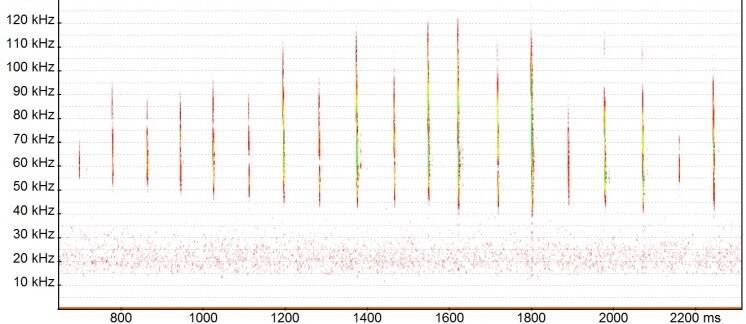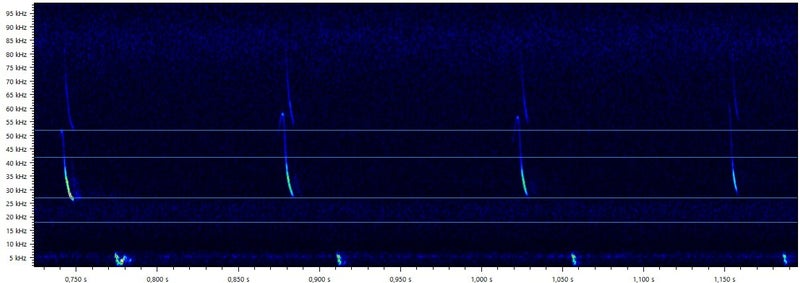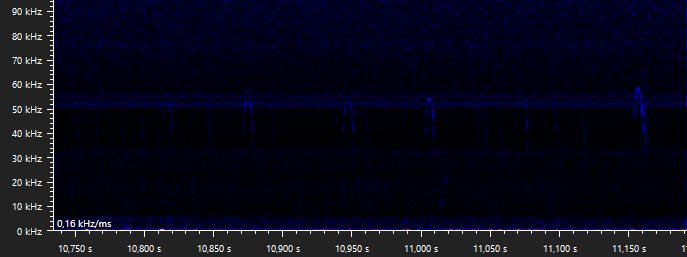Echolocation of bats in the Netherlands
Bats use echolocation to navigate and hunt, but they also make calls for communication. When a bat is hunting, the proces of catching an insect becomes visible by a so called feeding buzz. Examples of feeding buzzes can be found on the Feeding buzzes page. Calls used for communication can be found on the Social calls page.
The echolocation of bats are a great way to identify bat species, because the calls of each species has it's own specifications. The shape of the call, the peak frequency of the call, the start and end frequency of the call, the call length and the inter-pulse interval can all be important indicators to identify the species you are dealing with. Two great guides for bat identification are "Bat Calls of Britain and Europe" edited by Jon Russ and "Acoustic Ecology of Europan Bats" by Michel Barataud.
Different shapes
FM-qCF shaped calls are similar to a hockeystick or a bend: ╰
qCF shaped calls are similar to a mostly horizontal stripe: —
FM shaped calls are similar to a mostly vertical stripe: I
qCF-FM shaped calls are similar to the right half of a rainbow: ╮
FM-CF-FM shaped calls are similar to a coffee table: ┏┓
Peak frequency: the frequency (kHz) at which the call is loudest.
Start frequency: the frequency (kHz) at the start of the call.
End frequency: the frequency (kHz) at the end of the call.
Call length: the duration of the call (ms) from start to end.
Inter-pulse interval: the amount of time (ms) between calls.
Bandwith: Band length of a call (kHz); start - end frequency.
Examples
Greater Noctule (Nyctalus lasiopterus)
Grote rosse vleermuis
Distribution: rare in all of it's distribution. Vagrant status in the Netherlands with only one sighting in 1993 in Bovenkarpsel, Noord-Holland.
Peak frequency often between 10 to 20 kHz - usually qCF calls, sometimes alternated with FM-qCF calls - long call length - long inter-pulse interval - chip-chop sound

Date of recording: 2024-06-06 Recorded by: Magnus Karlsson Audio file: 911682 (not recorded in the Netherlands)
Common noctule (Nyctalus noctula)
Rosse vleermuis
Distribution: throughout the most of the Netherlands.
Peak frequency often around or just below 20 kHz - usually qCF calls, sometimes alternated with FM-qCF calls - relatively long inter-pulse interval - chip-chop sound

Date of recording: 2024-06-07 Recorded by: Timo Boer Audio file: 912080
Leisler's noctule (Nyctalus leisleri)
Bosvleermuis
Distribution: sparsly scattered throughout the whole of the Netherlands, not present in Zeeland and Flevoland.
Peak frequencty often around 25 kHz - qCF or FM-qCF calls, sometimes alternated - long inter-pulse interval - sometimes chip-chop sound

Date of recording: 2023-06-29 Recorded by: Arjan Boonman Audio file: 822528
Eurasian Particolored Bat (Vespertilio murinus)
Tweekleurige vleermuis
Distribution: sparsly scattered throughout the whole of the Netherlands.
Peak frequency often around 25 kHz - usually FM-qCF calls, sometimes qCF calls - regular inter-pulse interval - no chip-chop sound

Date of recording: 2024-07-18 Recorded by: Wieneke Huls Audio file: 322282020
Serotine bat (Eptesicus serotinus)
Laatvlieger
Distribution: throughout the most of the Netherlands.
Peak frequency often around 25 kHz - usually FM-qCF calls - regular inter-pulse interval - tapdancer sound

Date of recording: 2024-06-03 Recorded by: Nanieke van den Berg Audio file: 912083
Northern serotine (Eptesicus nilssonii)
Noordse vleermuis
Distribution: Vagrant status in the Netherlands with only three sightings: in 1993 and 1998 nearby Den Helder, Noord-Holland, and in 2003 in Leusden, Utrecht.
Peak frequency often around 30 kHz - usually FM-qCF calls, but qCF possible - unique frequency band (from 50 kHz to 30 kHz) - irregular pulse rythm

Date of recording: 2021-07-17 Recorded by: Stanislas Wroza Audio file: 805735 (not recorded in the Netherlands)
Nathusius pipistrelle (Pipistrellus nathusii)
Ruige dwergvleermuis
Distribution: throughout the most of the Netherlands.
Peak frequency often around 40 kHz - FM-qCF or qCF calls - dull bubbling sound

Common pipistrelle (Pipistrellus pipistrellus)
Gewone dwergvleermuis
Distribution: throughout the whole of the Netherlands.
Peak frequency often around 45 kHz - most often FM-qCF calls, but qCF possible - dull bubbling sound

Date of recording: 2024-05-23 Recorded by: Romee Bleijenberg Audio file: 912090
Soprano pipistrelle (Pipistrellus pygmaeus)
Kleine dwergvleermuis
Distribution: sparsly scattered throughout the whole of the Netherlands, not present in Flevoland.
Peak frequency often around 55 kHz - most often FM-qCF calls, but qCF possible - dull bubbling sound

Date of recording: 2025-08-27 Recorded by: Sarah Mahie Audio file: 1033629
Brown long-eared bat (Plecotus auritus)
Grey long-eared bat (Plecotus austriacus)
Gewone grootoorvleermuis
Grijze grootoorvleermuis
Distribution brown long-eared bat: throughout the most of the Netherlands.
Distribution grey long-eared bat: rare in the Netherlands, but present in Lumburg, the east of Noord-Brabant and the south of Zeeland.
Very difficult to distinguish the two species on their echolocation calls. Click here for a guide. The examples below are from brown long-eared bats.
Peak frequency often between 20 - 30 kHz - FM calls - calls contain harmonics - quiet crackling sound - can only be heard within 5 meters

Date of recording: 2024-06-26 Recorded by: Boaz van Die Audio file: 916851
Greater mouse-eared bat (Myotis myotis)
Vale vleermuis
Distribution: very rare in the Netherlands, but mainly present in the south of Limburg and the east of Overijssel. Not present in Flevoland, Friesland, Groningen, Noord-Holland and Zeeland.
Peak frequency often between 30 - 35 kHz - FM calls (wiggly-looking) - relatively long inter-pulse interval - short to relatively long call length - dry clicks

Date of recording: 2024-09-16 Recorded by: L.A. Leijdekkers Audio file: 328683784
Pond bat (Myotis dasycneme)
Meervleermuis
Distribution: throughout the most of the Netherlands, less densely in the east and south.
Peak frequency often around 35 to 40 kHz - FM calls - high start frequency and low end frequency - short to relatively long call length - rattle sound

Date of recording: 2024-05-18 Recorded by: Abe-Jan van der Wal Audio file: 912118
Daubenton's bat (Myotis daubentonii)
Watervleermuis
Distribution: scattered throughout the whole of the Netherlands, in particular densely present at the western coast line, Utrecht, Gelderland and Noord Brabant.
Peak frequency often around 45 to 50 kHz - FM calls - high start frequency and low end frequency - short call length - rattle sound

Whiskered Myotis (Myotis mystacinus)
Brandt's Myotis (Myotis brandtii)
Baardvleermuis
Brandts vleermuis
Distribution whiskered myotis: sparsly scattered throughout the whole of the Netherlands.
Distribution brandt's myotis: rare in the Netherlands, only present in the east of Overijssel and Gelderland, a small part of Utrecht and the south of Limburg.
Very difficult to distinguish the two species on their echolocation calls.
Peak frequency often around 45 to 50 kHz - FM calls - very high start frequency possible and low end frequency - quiet clicks - can only be heard within 5 - 7 meters

Date of recording: 2025-08-07 Recorded by: Floris Kouters Audio file: 1038588
Natterer's bat (Myotis nattereri)
Franjestaart
Distribution: sparsly scattered throughout the whole of the Netherlands, in particular more densely present in Utrecht and Gelderland.
Peak frequency often around 30 to 50 kHz - FM calls (often convex) - very high start frequency and very low end frequency - short call length - very dry sound

Date of recording: 2025-08-30 Recorded by: Sarah Mahie Audio file: 1033961
Bechstein's Myotis (Myotis bechsteinii)
Bechsteins vleermuis
Distribution: very rare bat in the netherlands, only more densily present in the south of Limburg and sparsely scattered throughout Overijssel and Gelderland.
Peak frequency often around 50 kHz - FM calls - very high start frequency and average bandwidht of 90 kHz - short call length - usually too quiet to be detected

Date of recording: 2023-09-15 Recorded by: Vladimír Nemček Audio file: 830021 (not recorded in the Netherlands)
More: 830023 (not recorded in the Netherlands)
Geoffroy's myotis (Myotis emarginatus)
Ingekorven vleermuis
Distribution: very rare in the Netherlands, mainly present in Limburg.
No clear peak frequency - FM calls - very high start frequency and high end frequency (above 40 kHz) - short inter-pulse intervals - short call length - very dry sound

Western barbastelle (Barbastella barbastellus)
Mopsvleermuis
Distribution: very rare in the Netherlands, only present in the south of Zeeland and the east of Gelderland.
Peak frequency often around 32 kHz (FM calls) - typically alternates between FM and qCF-FM calls - rattling sound similar to castanets

Date of recording: 2025-02-23 Recorded by: Alex Wieland Audio file: 975703
Greater horseshoe bat (Rhinolophus ferrumequinum)
Grote hoefijzerneus
Distribution: Almost totally disappeared in the Netherlands. Most likely to encounter the species in Limburg, but hibernating bats were also found near Utrecht in 1992 and near Den Haag, Zuid-Holland, in 2020 and 2021.
Peak frequency often around 80 kHz - FM-CF-FM calls - continuous warbling sound

Date of recording: 2025-07-25 Recorded by: Sarah Mahie Audio file: 1020280 (not recorded in the Netherlands)
Lesser Horseshoe Bat (Rhinolophus hipposideros)
Kleine hoefijzerneus
Distribution: Currently extinct in the Netherlands. Were only present in Limburg with the last sighting from 1983. In 2019 a bat was found in Steenokkerzeel, Vlaanderen, Belgium.
Peak frequency often around 110 kHz - FM-CF-FM calls - continuous warbling sound

Date of recording: 2024-05-29 Recorded by: brickegickel Audio file: 910362 (not recorded in the Netherlands)
New species in the Netherlands?
Bats are flying creatures, so vagrants are not to be unexpected. However, audio recordings often provide not enough proof to declare the presence of a new species.
Alcathoe whiskered myotis (Myotis alcathoe)
Nimfvleermuis
Distribution: Official sightings in Hermeton-sur-Meuse and Rochefort, Belgium, in 2008 and 2011.
FM calls - explosive start on high frequencies - no final whack in approach phases - no abs high in cruising phase

As can be read in the description of the original sightings, expert Michel Barataud is certain of the species in the provided four recordings made in Clinge, Zeeland.
His advice: "The wisdom could be to keep this data apart, and try to confirm with capture (one more step of certainty, but not absolute too with M. alcathoe...) and genetic analysis (the current most confident method, but not so easy to perform... and may be one day replaced by a better method."
Date of recording: 2017-05-07 Recorded by: Joris Everaert Location: Clinge, Zeeland Image source: 138620068
Kuhl's Pipistrelle (Pipistrellus kuhlii)
Kuhl's dwergvleermuis
Distribution: Official sightings from Evenbroek, Belgium, in 2019 and Brussel, Belgium, in 2012 and 2020.
Peak frequency often around 40 kHz - most often FM-qCF calls, but qCF possible - calls occasionally have an FM ending - difficult to distinguish from P. nathusii

Date of recording: 2025-08-10 Recorded by: Paul Dujardin Location: Roosendaal, Noord-Brabant Audio file: 368568052
More: 1048162
Savi's Pipistrelle (Hypsugo savii)
Savi's dwergvleermuis
Distribution: A small population is present just across the border near Ahaus, Germany.
Peak frequency often around 35 kHz - most often FM-qCF calls, but qCF possible - somewhat subdued rhythm

Date of recording: 2025-06-25 Recorded by: Gaia Ecologie Location: Giethoorn, Overijssel Audio file: 1025154
Deviations
Bats leaving their roost
Directly at emergence from the roost, echolocation calls are typically short in duration and elevated in frequency and are not typical of free-flying bats (Newson, 2024).
Common noctule leaving it's roost:

Date of recording: 2024-04-28 Recorded by: Dennis Rademaker Audio file: 920109
Serotine bat leaving it's roost:

Date of recording: 2024-05-19 Recorded by: Sander Boersma Audio file: 912051
Brown long-eared bat leaving it's roost:

Date of recording: 2024-07-13 Recorded by: Boaz van Die Audio file: 921381
Common pipistrelle leaving it's roost:

Date of recording: 2024-06-17 Recorded by: Sarah Mahie, Boaz van Die Audio file: 914381
Modified echolocation calls
Examples of modified echolocation calls are very rare and so far previous literature written about these calls have not been able to determine the context behind such emissions. They may be communicative, at least to some degree (Middleton et al., 2020).
Hooked echolocation calls of the common pipistrelle:


Date of recording: 2024-06-20 Recorded by: Francien van Langen Audio file: 915128
Hooked echolocation calls of the Nathusius' pipistrelle:

Date of recording: 2025-05-30 Recorded by: Martin de Jong Audio file: 1008337
Hooked echolocation calls of the common noctule:


Hooked echolocation calls of the serotine bat:

Date of recordings: 2025-05-23 Location: Ede, Gelderland, The Netherlands

Date of recordings: 2025-04-28
Location: Ede, Gelderland, The Netherlands
Audio file: 1001695
Not to be confused with the social calls shaped like walking sticks of the pond bat and the Daubenton's bat. And, perhaps, there is also some similarity to the rare social calls of the serotine bat emitted while in flight that can appear as arches.
Social calls of the Daubenton's bat:


More: 931817
Social calls of the pond bat:

Date of recording: 2024-06-06 Recorded by: Anice Hut Audio file: 911253
All recordings are licensed under the following Creative Commons Attribution-NonCommercial-NoDerivs 4.0 license and in courtesy of Sarah Mahie.
All sonograms are screenshots of the recordings imported in the ultrasound analysis software BatExplorer 2.2 (Elekon, Switzerland).
Bibliography:
- Jon Russ (2021). Bat Calls of Britain and Europe: a Guide to Species Identification. Pelagic Publishing.
- Michel Barataud (2020). Acoustic Ecology of European Bats. Species Identification, Study of their Habitats and Foraging Behaviour (Anya Cockle-Betian, trans.). Second edition. Inventaires & biodiversité series. Biotope - Muséum national d'Hostoire naturelle.
- Neil Middleton, Andrew Froud and Keith French (2022). Social Calls of the Bats of Britain and Ireland (second edition). Pelagic Publishing.
- Stuart Newson (2024). https://www.linkedin.com/posts/stuart-newson


Create Your Own Website With JouwWeb